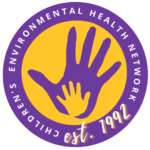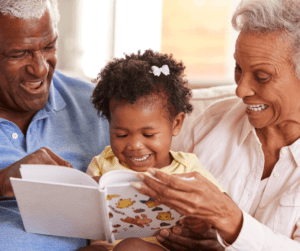CEH Day & Child Care Wins
kristiet_a0o04rjz
on
September 26, 2022
CEH Day & Child Care Wins
By Kathy Attar, Program Manager, Eco-Healthy Child Care®
October 2022
Celebrate Children’s Environmental Health Day (CEH Day) with us on October 13th!
An estimated 34% of children’s chronic illnesses and developmental problems are caused by environmental factors. These harms disproportionately affect children from families with lower incomes and Black, Latinx, Indigenous, and other children of color.
CEH DAY raises the profile of children’s health issues, celebrates successes in the field, and discusses new challenges and the road ahead. We hope you’ll join us!
Recent Children’s Environmental Health Successes in the Child Care Field
The Eco-Healthy Child Care® program (EHCC) works to protect children and child care staff from environmental hazards found in child care settings.
Through private foundation funding, EHCC, and its partners, the National Center for Healthy Housing and National Association for Family Child Care, established a network of family child care leaders, the–Getting Ahead of Lead Leaders Network–to build leadership within the family child care field to tackle issues of lead poisoning in home-based child cares. The network comprises racially and geographically diverse family child care providers committed to protecting children’s health from environmental hazards. Over the past year, these family child care leaders completed over eight hours of training in environmental health. They will now go out into their communities and train other child care providers and community members on best practices for eliminating environmental hazards in homes and child care settings.
Incorporating professional development on environmental health into the state child care system is key to creating change. Several states have begun this process. The states of New York and New Hampshire have purchased the usage of EHCC’s Protecting Children’s Environmental Health e-course to distribute free of charge to child care licensing staff and providers. The course trains child care professionals on best practices for reducing environmental hazards like pesticides, lead, and toxic chemicals found in cleaning products.
Cleaning up the indoor air in child care facilities is essential to improving children’s environmental health. With funding from the Environmental Protection Agency (EPA), EHCC will measure the air quality in child care centers before and after the introduction of eco-healthy best practices. EHCC, the Helen Walton Children’s Enrichment Center, and McMac Cx were awarded an EPA grant to monitor the indoor air quality of child care facilities in northwest Arkansas, focusing on those serving Black, Brown, Indigenous, and low-income families. The collected research results will be used to improve EHCC’s best practice protocols and to drive policy and regulatory change within the child care system,
To add value to EHCC’s endorsement program, a virtual technical assistance program for endorsed child care providers was recently launched. Providers can now receive FREE one-on-one TA from EHCC staff. The TA session is an opportunity to relay the latest scientifically based best practices for creating safer and healthier child cares. Lessons learned from these sessions will be used to improve EHCC’s education and policy efforts.
Celebrate these wins and learn more about the road ahead on October 13th–CEH Day!
Día CEH y victorias de cuidado infantil
Celebre Día de la Salud Ambiental Infantil (Día CEH) con nosotros el 13 de octubre!
Se estima que el 34% de las enfermedades crónicas y los problemas de desarrollo de los niños son causados por factores ambientales. Estos daños afectan de manera desproporcionada a los niños de familias con ingresos más bajos, así como a los niños negros, latinxs, indígenas y otros niños de color.
El DÍA CEH eleva el perfil de los problemas de salud infantil, celebra los éxitos en el campo y analiza los nuevos desafíos y el camino a seguir. ¡Esperamos que te unas a nosotros!
Éxitos recientes de salud ambiental infantil en el campo del cuidado infantil
El programa Eco-Healthy Child Care® (EHCC) trabaja para proteger a los niños y al personal de cuidado infantil de los peligros ambientales que se encuentran en los entornos de cuidado infantil.
A través de fondos de fundaciones privadas, EHCC y sus socios, la National Center for Healthy Housing (el Centro nacional de viviendas saludables) y la National Association for Family child Care (la Asociación nacional para el cuidado infantil familiar), estableció una red de líderes de cuidado infantil familiar, la Red de líderes adelantándose del plomo,para crear liderazgo dentro del campo del cuidado infantil familiar para abordar los problemas de envenenamiento por plomo en los cuidados infantiles en el hogar. La red está compuesta por proveedores de cuidado infantil familiar racial y geográficamente diversos comprometidos con proteger la salud de los niños de los peligros ambientales. Durante el año pasado, estos líderes de cuidado infantil familiar completaron más de ocho horas de capacitación en salud ambiental. Ahora irán a sus comunidades y capacitarán a otros proveedores de cuidado infantil y miembros de la comunidad sobre las mejores prácticas para eliminar los peligros ambientales en los hogares y entornos de cuidado infantil.
La incorporación de desarrollo profesional sobre la salud ambiental en el sistema estatal de cuidado infantil es clave para generar cambios. Varios estados han iniciado este proceso. Los estados de Nueva York y New Hampshire compraron el uso del curso electrónico Protección de la salud ambiental de los niños para distribuirlo sin cargo al personal y proveedores de licencias de cuidado infantil. El curso capacita a los profesionales del cuidado infantil en las mejores prácticas para reducir los peligros ambientales como los pesticidas, el plomo y los productos químicos tóxicos que se encuentran en los productos de limpieza.
La limpieza del aire interior en las instalaciones de cuidado infantil es esencial para mejorar la salud ambiental de los niños. Con fondos de la Environmental Protection Agency EPA (Agencia de protección ambiental), EHCC medirá la calidad del aire en los centros de cuidado infantil antes y después de la introducción de las mejores prácticas ecosaludables. EHCC, el Helen Walton Children’s Enrichment Center (Centro de enriquecimiento infantil Helen Walton) y McMac Cx recibieron una subvención de la EPA para monitorear la calidad del aire interior de las instalaciones de cuidado infantil en el noroeste de Arkansas, enfocándose en aquellos que atienden a familias negras, marrones, indígenas y de bajos ingresos. Los resultados de la investigación recopilados se utilizarán para mejorar los protocolos de mejores prácticas de EHCC y para impulsar cambios normativos y regulatorios dentro del sistema de cuidado infantil.
Para agregar valor al programa de respaldo de EHCC, recientemente se lanzó un programa de asistencia técnica virtual (TA) para proveedores de cuidado infantil respaldados. Los proveedores ahora pueden recibir asistencia técnica individual GRATUITA del personal de EHCC. La sesión de TA es una oportunidad para transmitir las últimas mejores prácticas con base científica para crear entornos más seguras y saludables. Las lecciones aprendidas de estas sesiones se utilizarán para mejorar los esfuerzos de educación y políticas de EHCC.
Celebre estas victorias y aprenda más sobre el camino a seguir el 13 de octubre:Día de CEH!








